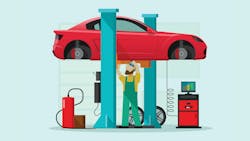When Doug Grills and his partner started AutoStream Car Care in 1999, they operated out of small spaces with just three or four repair bays apiece—a size they quickly outgrew.
Nearly a quarter-century later, Grills considers eight to 10 bays per location as the ideal for his business, which has nine shops in the Baltimore and Washington, D.C. market. His reasons are a mix of factors: meeting customer demand, providing quality service, reaching revenue goals and taking advantage of operational and staffing efficiencies.
In that mix, anecdotal evidence and even gut feelings do play a role. “As much as you want the decision about the right number of bays to be all about science and data, every owner and every location are unique,” he says. “For me, it has to be a combination of art and science.”
The most common basis for an expansion, of course, is when customer demand clearly outpaces service capacity. One metric to track is the conversion ratio of phone calls to a shop, notes Michael Rosenberger, CEO/Owner of Tommy’s Hi Tech Auto Repair, which has two locations near Dallas, Texas.
For Rosenberger, a bare minimum standard is the ability to schedule 60% of incoming calls within a day or two. However, he generally aims for between 80% and 90%.
“If we’re not hitting the 80% to 85% percent mark at a shop, I’m either doing some training for my service advisors or thinking that it’s time to grow or expand,” he says. “That could be either adding bays to an existing building or beginning to look at new locations.”
Adds Grills: “You know when you’re missing out on opportunities. The goal is always to say ‘yes’ to customers and provide same-day service. In today’s environment, you also have to be aware that even customers who are loyal to you and love you have limits on what they are willing to accept and how long they’re willing to wait on you.”
That said, shops’ business models, customer bases and financial goals can vary widely, all of which impact the question of how many bays make sense.
For example, a shop that works mainly on European or specialty vehicles will have a higher average repair order (ARO) than a business servicing all makes and models. The former likely would need fewer bays to meet revenue goals than one with a lower ARO model.
Shop owners also have different operational methods. In Rosenberger’s case, he aims to have a technician in every bay—with a floating foreman if possible—and to collect an average of $40,000 to $50,000 in monthly revenue per bay. He also wants to have a minimum of three service advisors.
Other shops will have more than one technician per bay, and/or communal bays designed for straightforward tasks such as alignments, oil changes and tire rotations.
Before adding work areas, Rosenberger generally wants to see all of his existing bays handling a full-time workload, or at least 40 billed hours a week.
“Getting over 100% efficiency out of every bay is different from getting 100% efficiency out of every technician,” he explains. “I usually advise owners to maximize the use of their physical space first and to be very careful about expanding.”
Large same-store expansions will add significant overhead and operational complexities, he continues. That includes the need for more technicians, service advisors, managers and office space, plus staff training on handling higher volumes of customers and incoming phone calls.
So, while growing from four bays to five or six should be fairly manageable, an owner considering doubling the size of an eight-bay shop might want to investigate opening a separate new location instead.
Grills agrees that using all available space in a building and lot is wise, as the cost of adding one more bay in a modest expansion—putting in three new work areas, say, rather than two—should only be incrementally higher.
In addition to considering parking availability and traffic flow, owners also need to be realistic about how much revenue they can expect to produce at each bay, he says:
“In my market, we’re looking to average $25,000-plus a month in a bay. If you want to produce $200,000 in monthly revenue, then, it’s going to be very hard—if not impossible—to hit that sales level with four bays; you would need an enormous amount of business and very quick turnover on jobs. Sustaining that level of output week in and week out over time in a facility of that size is the challenge. It’s a much more likely achievement if you have eight bays.”
On the flip side, if bays are too often unused or functioning largely as storage or parking areas in a shop, tackling technician efficiency and productivity and/or scheduling systems should take precedence over any desire to grow.
One of Rosenberger’s tips for new owners is to think about what kind of shop will serve their financial, community and personal goals well before opening. “A lot of people think, ‘Oh, I’ll get this shop and see what it can do,’” he says. “Really, the shop should be the vehicle for getting you to where you’ve already decided you want to be.”
And while industry experts and other shop owners are always valuable resources, those decisions ultimately come down to an individual. That’s where the “art” in “art and science” comes in.
“The way I look at it, shops are like your kids,” Grills relates. “You love all of them, but they’re never the same. Each one needs different things from you to be their best.”
